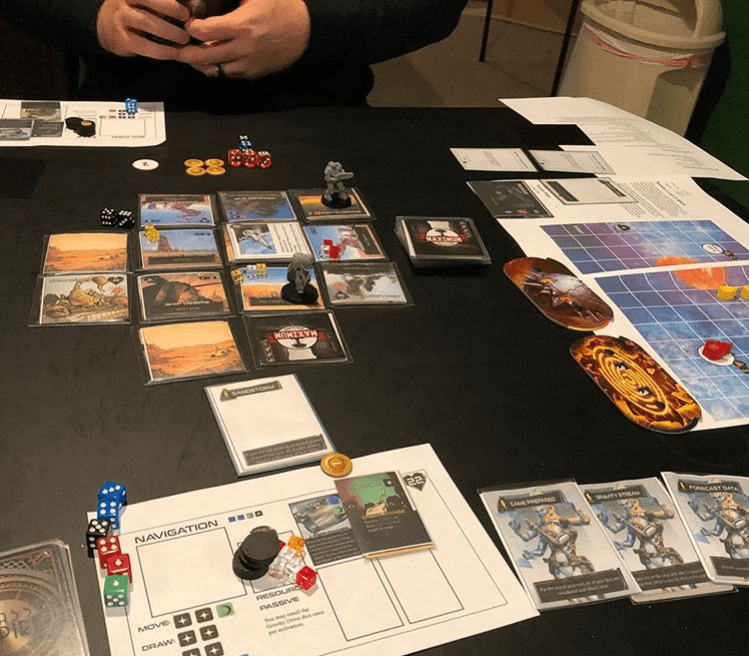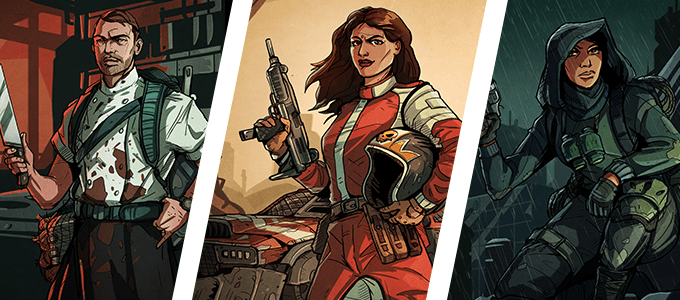Here are Rock Manor Games, our games take quite a bit of time. Our fastest turnaround on developing a board game was probably Gothic Horrors and that was an expansion and still took over a year. Most of our new games take about 2 years to get to Kickstarter which is ~3 years to actually get in gamers’ hands. Our upcoming game, Lawyer Up was originally conceived 4 Gencons ago back in 2016. I’m sure some people reading this are thinking, “What takes them so long?”… well I’ll do my best to explain our process. Whether or not you think our development time is justified is probably subjective.
From Concept to Prototype
I’ve never met a Game Designer that didn’t have a notebook full of game ideas and a closet, shed or some other place full of old prototypes that never got published. How do we pick what game ideas to actually make prototypes for and how do we pick which prototypes and games to actually produce and take to Kickstarter? In the case of Lawyer Up, it was just an idea that kept nagging at me.
I’m not quite sure when I first had the idea for a Lawyer card game. A bunch of my friends are attorneys (like almost a dozen of them). At some point I was talking to one of them. They were asking me all about board games and I was trying to explain it all to them. During the conversation, I realized that I had never seen a game based on the courtroom before. This was surprising to me because there are SO MANY TV legal dramas. Needless to say, I started thinking about how a Lawyer game would work. It was just one of those things in the back of my head.

At some point at Gencon 2016, Sam and I were hanging out and I brought up this idea for a Lawyer card game. I talked about some of the basic things I thought would work and Sam thought it was interesting. Over the next year, Sam and I continued to chat about it. Sam had this influence swaying thing in a Fairy game that we thought would work for the Jury in this Lawyer game. It all culminated with Sam staying up all night before traveling to Gencon 2017, making a prototype for Lawyer Up.
That’s just a quick anecdote about how the Lawyer Up took a year from concept to prototype. It’s a bit easier to pin down the timeline because it was a collaboration. I tend to walk around with my game design ideas a lot before I actually sit down at a computer to make a prototype. I usually start in Excel brainstorming and jotting down cards, effects and other ideas before I ever mock-up an actual card or component in the game for a prototype. It’s a creative process and not something I think you can assign deadlines to. A lot of times, the ideas never go any further than that or they just sit as an excel spreadsheet in a folder on my computer. The point is that we pursue the game ideas and make prototypes for the games we’re most passionate and excited about.
Fail Fast, Iterate, Fail Again, Iterate, Iterate, Iterate
I think Unpub’s slogan is “Fail Faster”, which I adore. It’s very true. Our development process is very much about playing a game over and over again, finding the fun bits and tweaking the parts that don’t work over and over again. Failing and iteration is all part of it. When you publish a game, you’re going to end up playing it hundreds and hundreds of times. If a game isn’t fun enough, you’ll realize pretty early on during the iteration process.

When Sam brought the first iteration of Lawyer Up to Gencon 2017, we played it and had numerous changes as soon as we finished… but it was fun enough that we wanted to play it again. I think we played it 3-4 times in a row on that Wednesday night before the convention started. We basically kept iterating and changing it as much as we could with what we had in front of us. Eventually we got to the point where the game was not only way better, but the remaining changes really needed to be made back on the original computer files and the cards printed again. After playing the game that night, I knew we had a prototype that I wanted to produce.
I had a similar experience with Set a Watch. I played it at a Game Makers Guild of Philadephia meetup and it just stayed with me. I found myself thinking about how cool it was at every GMG meeting over the following months. I think it was almost 6 months before Todd brought it back and I immediately volunteered to playtest it again. Even though I didn’t design Set a Watch, we had a similar process as we developed the camp actions, locations cards and abilities. Todd and I playtested and met up month after month to continue to iterate and refine the game while we started Art Production.
We don’t crowdfund games until nearly all of the art is completed
If you can’t tell, we invest A LOT into the games we produce. We’re a small indie publisher and will never be able to put out more than a handful of games a year, so we really want to make sure that every game meets our high standards. When we’re still excited about a prototype iteration after iteration, it eventually makes its way into Art Production. This is where we start investing more than just our time into the game. We look at artist portfolios and start getting quotes and discussing the overall look/theme/tone of the game. We select an artist and then they start making art. Usually as the artists starts toiling away at pieces for the game, we continue to develop the game and playtest it. It’s always exciting to update a prototype with actual art or graphic design for the game as it slowly makes its way from ugly duckling prototype to prettier “preview” quality prototype.
Eventually, the game gets to a point where it is nearly finished from both a development and art production standpoint and this is when we start looking at our Kickstarter launch. How long artists take is vastly different. For some games, we have used one artist (Maximum Apocalypse, Brass Empire) for the entire project. For Lawyer Up and Set a Watch, we’ve used a handful of different artists to each work on distinct decks of cards for each game. For Set a Watch, we had 99% of the artwork complete well before Gencon and decided to actually manufacture prototypes/review copies with Longpack to get a jump on Manufacturing and have a great prototype to distribute to reviewers. Lawyer Up’s prototype was all final art except for the Judge card.

This is definitely a point in the process that can suffer from delays. Freelance artists have their own schedule and even the same artist can deliver 10 cards once month and then next month only have time for 3. In general, I’d say to expect between 5-10 pieces from a freelance artist a month on average so depending on the size of your game (the murder case has 82 unique pieces of art), art production can take 6-18 months. We never want these type of delays to affect our backers which is why we always make sure that we are nearly done all of the art production before we go to Kickstarter. Another great reason for waiting for almost all the art and graphic design to be completed is that you have better looking prototypes to send to reviewers/content creators for videos etc. and of course better images to show off the game on Kickstarter as well.
Showing the game to the public
Some time during the Art Production and Development process, we start showing the game off to the public. We will take prototypes and games we have announced and are working on to conventions, setup events, demos and playtests. When I was just starting out, I hit the pavement with Maximum Apocalypse and took it around to conventions for about a year before we launched on Kickstarter. We’ve been continuing that tradition. Maximum RPG had hours and hours of events at Origins last June and Lawyer Up was first shown on camera at Origins 2019. The Murder and Witch case were demoed at Gencon 2019 and Prohibition and Witch were demoed at Metatopia in November 2019. The Few and Cursed was first playable at Unpub in 2018… it changed a lot over that weekend. The point is that we’re always looking for feedback and never want to rush our games. Even after Kickstarter, we usually do some final playtesting and balancing to make sure stretch goals work and attempt to catch any last minute gameplay issues.
We’re actually heading to PAX East this week and while we’re always focused on selling games we have released and in stock, we always have expansions, prototypes and more with us if you ask nicely. I know that we’ll definitely hoping to playtest more of the new Set a Watch stuff since it’s really coming along nicely.
It’s the Creative Process
Making Games is a creative process and that creativity can be smothered by stringent timelines and deadlines. I got into this business to make the kind of games that I was yearning to play. I’ve been fortunate to have success and feel it’s important to give projects the time that they need to breathe and develop. Does it mean that we take longer to develop and release games compared to other publishers? Yes, but I think our games are better for it. Rock Manor Games are ready when they’re ready.

Leave a Reply